Huaimin Wang
Evolutionary training-free guidance in diffusion model for 3D multi-objective molecular generation
May 16, 2025Abstract:Discovering novel 3D molecular structures that simultaneously satisfy multiple property targets remains a central challenge in materials and drug design. Although recent diffusion-based models can generate 3D conformations, they require expensive retraining for each new property or property-combination and lack flexibility in enforcing structural constraints. We introduce EGD (Evolutionary Guidance in Diffusion), a training-free framework that embeds evolutionary operators directly into the diffusion sampling process. By performing crossover on noise-perturbed samples and then denoising them with a pretrained Unconditional diffusion model, EGD seamlessly blends structural fragments and steers generation toward user-specified objectives without any additional model updates. On both single- and multi-target 3D conditional generation tasks-and on multi-objective optimization of quantum properties EGD outperforms state-of-the-art conditional diffusion methods in accuracy and runs up to five times faster per generation. In the single-objective optimization of protein ligands, EGD enables customized ligand generation. Moreover, EGD can embed arbitrary 3D fragments into the generated molecules while optimizing multiple conflicting properties in one unified process. This combination of efficiency, flexibility, and controllable structure makes EGD a powerful tool for rapid, guided exploration of chemical space.
Pay More Attention to the Robustness of Prompt for Instruction Data Mining
Mar 31, 2025Abstract:Instruction tuning has emerged as a paramount method for tailoring the behaviors of LLMs. Recent work has unveiled the potential for LLMs to achieve high performance through fine-tuning with a limited quantity of high-quality instruction data. Building upon this approach, we further explore the impact of prompt's robustness on the selection of high-quality instruction data. This paper proposes a pioneering framework of high-quality online instruction data mining for instruction tuning, focusing on the impact of prompt's robustness on the data mining process. Our notable innovation, is to generate the adversarial instruction data by conducting the attack for the prompt of online instruction data. Then, we introduce an Adversarial Instruction-Following Difficulty metric to measure how much help the adversarial instruction data can provide to the generation of the corresponding response. Apart from it, we propose a novel Adversarial Instruction Output Embedding Consistency approach to select high-quality online instruction data. We conduct extensive experiments on two benchmark datasets to assess the performance. The experimental results serve to underscore the effectiveness of our proposed two methods. Moreover, the results underscore the critical practical significance of considering prompt's robustness.
NebulaFL: Effective Asynchronous Federated Learning for JointCloud Computing
Dec 06, 2024Abstract:With advancements in AI infrastructure and Trusted Execution Environment (TEE) technology, Federated Learning as a Service (FLaaS) through JointCloud Computing (JCC) is promising to break through the resource constraints caused by heterogeneous edge devices in the traditional Federated Learning (FL) paradigm. Specifically, with the protection from TEE, data owners can achieve efficient model training with high-performance AI services in the cloud. By providing additional FL services, cloud service providers can achieve collaborative learning among data owners. However, FLaaS still faces three challenges, i.e., i) low training performance caused by heterogeneous data among data owners, ii) high communication overhead among different clouds (i.e., data centers), and iii) lack of efficient resource scheduling strategies to balance training time and cost. To address these challenges, this paper presents a novel asynchronous FL approach named NebulaFL for collaborative model training among multiple clouds. To address data heterogeneity issues, NebulaFL adopts a version control-based asynchronous FL training scheme in each data center to balance training time among data owners. To reduce communication overhead, NebulaFL adopts a decentralized model rotation mechanism to achieve effective knowledge sharing among data centers. To balance training time and cost, NebulaFL integrates a reward-guided strategy for data owners selection and resource scheduling. The experimental results demonstrate that, compared to the state-of-the-art FL methods, NebulaFL can achieve up to 5.71\% accuracy improvement. In addition, NebulaFL can reduce up to 50% communication overhead and 61.94% costs under a target accuracy.
AutoFeedback: An LLM-based Framework for Efficient and Accurate API Request Generation
Oct 09, 2024



Abstract:Large Language Models (LLMs) leverage external tools primarily through generating the API request to enhance task completion efficiency. The accuracy of API request generation significantly determines the capability of LLMs to accomplish tasks. Due to the inherent hallucinations within the LLM, it is difficult to efficiently and accurately generate the correct API request. Current research uses prompt-based feedback to facilitate the LLM-based API request generation. However, existing methods lack factual information and are insufficiently detailed. To address these issues, we propose AutoFeedback, an LLM-based framework for efficient and accurate API request generation, with a Static Scanning Component (SSC) and a Dynamic Analysis Component (DAC). SSC incorporates errors detected in the API requests as pseudo-facts into the feedback, enriching the factual information. DAC retrieves information from API documentation, enhancing the level of detail in feedback. Based on this two components, Autofeedback implementes two feedback loops during the process of generating API requests by the LLM. Extensive experiments demonstrate that it significantly improves accuracy of API request generation and reduces the interaction cost. AutoFeedback achieves an accuracy of 100.00\% on a real-world API dataset and reduces the cost of interaction with GPT-3.5 Turbo by 23.44\%, and GPT-4 Turbo by 11.85\%.
Enhancing Decision-Making for LLM Agents via Step-Level Q-Value Models
Sep 14, 2024



Abstract:Agents significantly enhance the capabilities of standalone Large Language Models (LLMs) by perceiving environments, making decisions, and executing actions. However, LLM agents still face challenges in tasks that require multiple decision-making steps. Estimating the value of actions in specific tasks is difficult when intermediate actions are neither appropriately rewarded nor penalized. In this paper, we propose leveraging a task-relevant Q-value model to guide action selection. Specifically, we first collect decision-making trajectories annotated with step-level Q values via Monte Carlo Tree Search (MCTS) and construct preference data. We then use another LLM to fit these preferences through step-level Direct Policy Optimization (DPO), which serves as the Q-value model. During inference, at each decision-making step, LLM agents select the action with the highest Q value before interacting with the environment. We apply our method to various open-source and API-based LLM agents, demonstrating that Q-value models significantly improve their performance. Notably, the performance of the agent built with Phi-3-mini-4k-instruct improved by 103% on WebShop and 75% on HotPotQA when enhanced with Q-value models, even surpassing GPT-4o-mini. Additionally, Q-value models offer several advantages, such as generalization to different LLM agents and seamless integration with existing prompting strategies.
Online Self-Preferring Language Models
May 23, 2024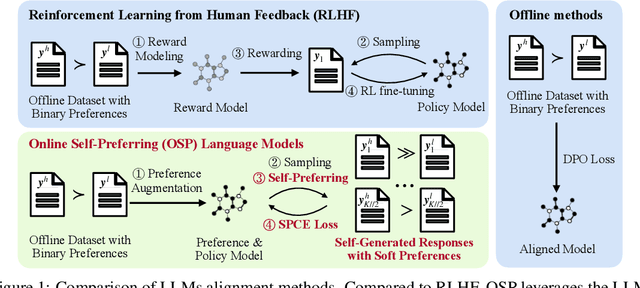


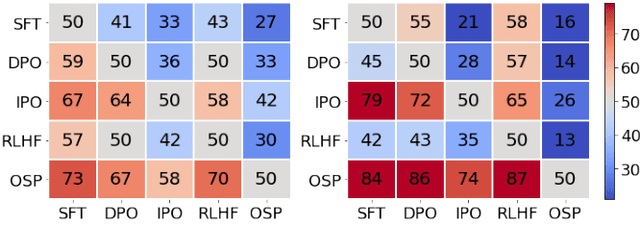
Abstract:Aligning with human preference datasets has been critical to the success of large language models (LLMs). Reinforcement learning from human feedback (RLHF) employs a costly reward model to provide feedback for on-policy sampling responses. Recently, offline methods that directly fit responses with binary preferences in the dataset have emerged as alternatives. However, existing methods do not explicitly model preference strength information, which is crucial for distinguishing different response pairs. To overcome this limitation, we propose Online Self-Preferring (OSP) language models to learn from self-generated response pairs and self-judged preference strengths. For each prompt and corresponding self-generated responses, we introduce a ranked pairing method to construct multiple response pairs with preference strength information. We then propose the soft-preference cross-entropy loss to leverage such information. Empirically, we demonstrate that leveraging preference strength is crucial for avoiding overfitting and enhancing alignment performance. OSP achieves state-of-the-art alignment performance across various metrics in two widely used human preference datasets. OSP is parameter-efficient and more robust than the dominant online method, RLHF when limited offline data are available and generalizing to out-of-domain tasks. Moreover, OSP language models established by LLMs with proficiency in self-preferring can efficiently self-improve without external supervision.
Optimistic Model Rollouts for Pessimistic Offline Policy Optimization
Jan 11, 2024



Abstract:Model-based offline reinforcement learning (RL) has made remarkable progress, offering a promising avenue for improving generalization with synthetic model rollouts. Existing works primarily focus on incorporating pessimism for policy optimization, usually via constructing a Pessimistic Markov Decision Process (P-MDP). However, the P-MDP discourages the policies from learning in out-of-distribution (OOD) regions beyond the support of offline datasets, which can under-utilize the generalization ability of dynamics models. In contrast, we propose constructing an Optimistic MDP (O-MDP). We initially observed the potential benefits of optimism brought by encouraging more OOD rollouts. Motivated by this observation, we present ORPO, a simple yet effective model-based offline RL framework. ORPO generates Optimistic model Rollouts for Pessimistic offline policy Optimization. Specifically, we train an optimistic rollout policy in the O-MDP to sample more OOD model rollouts. Then we relabel the sampled state-action pairs with penalized rewards and optimize the output policy in the P-MDP. Theoretically, we demonstrate that the performance of policies trained with ORPO can be lower-bounded in linear MDPs. Experimental results show that our framework significantly outperforms P-MDP baselines by a margin of 30%, achieving state-of-the-art performance on the widely-used benchmark. Moreover, ORPO exhibits notable advantages in problems that require generalization.
Uncertainty-Penalized Reinforcement Learning from Human Feedback with Diverse Reward LoRA Ensembles
Dec 30, 2023Abstract:Reinforcement learning from human feedback (RLHF) emerges as a promising paradigm for aligning large language models (LLMs). However, a notable challenge in RLHF is overoptimization, where beyond a certain threshold, the pursuit of higher rewards leads to a decline in human preferences. In this paper, we observe the weakness of KL regularization which is commonly employed in existing RLHF methods to address overoptimization. To mitigate this limitation, we scrutinize the RLHF objective in the offline dataset and propose uncertainty-penalized RLHF (UP-RLHF), which incorporates uncertainty regularization during RL-finetuning. To enhance the uncertainty quantification abilities for reward models, we first propose a diverse low-rank adaptation (LoRA) ensemble by maximizing the nuclear norm of LoRA matrix concatenations. Then we optimize policy models utilizing penalized rewards, determined by both rewards and uncertainties provided by the diverse reward LoRA ensembles. Our experimental results, based on two real human preference datasets, showcase the effectiveness of diverse reward LoRA ensembles in quantifying reward uncertainty. Additionally, uncertainty regularization in UP-RLHF proves to be pivotal in mitigating overoptimization, thereby contributing to the overall performance.
Intelligent Computing: The Latest Advances, Challenges and Future
Nov 21, 2022Abstract:Computing is a critical driving force in the development of human civilization. In recent years, we have witnessed the emergence of intelligent computing, a new computing paradigm that is reshaping traditional computing and promoting digital revolution in the era of big data, artificial intelligence and internet-of-things with new computing theories, architectures, methods, systems, and applications. Intelligent computing has greatly broadened the scope of computing, extending it from traditional computing on data to increasingly diverse computing paradigms such as perceptual intelligence, cognitive intelligence, autonomous intelligence, and human-computer fusion intelligence. Intelligence and computing have undergone paths of different evolution and development for a long time but have become increasingly intertwined in recent years: intelligent computing is not only intelligence-oriented but also intelligence-driven. Such cross-fertilization has prompted the emergence and rapid advancement of intelligent computing. Intelligent computing is still in its infancy and an abundance of innovations in the theories, systems, and applications of intelligent computing are expected to occur soon. We present the first comprehensive survey of literature on intelligent computing, covering its theory fundamentals, the technological fusion of intelligence and computing, important applications, challenges, and future perspectives. We believe that this survey is highly timely and will provide a comprehensive reference and cast valuable insights into intelligent computing for academic and industrial researchers and practitioners.
Self-Supervised Exploration via Temporal Inconsistency in Reinforcement Learning
Aug 24, 2022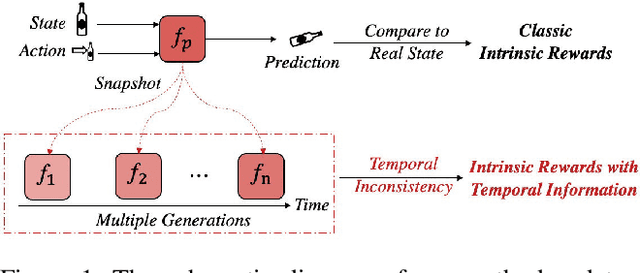
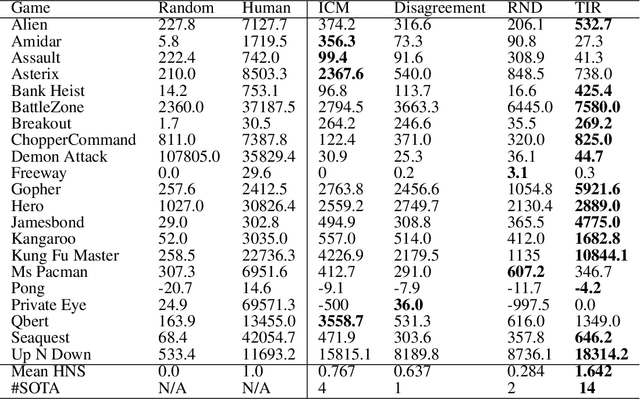
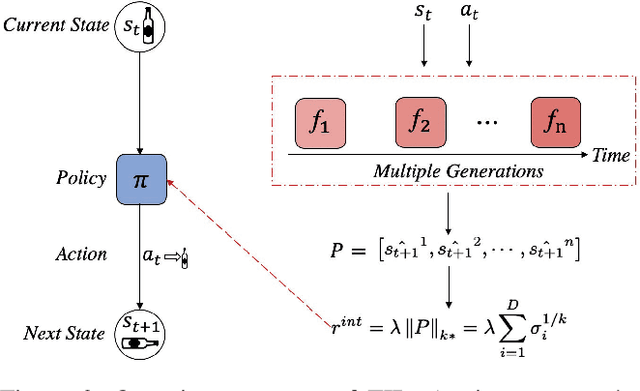

Abstract:In real-world scenarios, reinforcement learning under sparse-reward synergistic settings has remained challenging, despite surging interests in this field. Previous attempts suggest that intrinsic reward can alleviate the issue caused by sparsity. In this paper, we present a novel intrinsic reward that is inspired by human learning, as humans evaluate curiosity by comparing current observations with historical knowledge. Specifically, we train a self-supervised prediction model and save a set of snapshots of the model parameters, without incurring addition training cost. Then we employ nuclear norm to evaluate the temporal inconsistency between the predictions of different snapshots, which can be further deployed as the intrinsic reward. Moreover, a variational weighting mechanism is proposed to assign weight to different snapshots in an adaptive manner. We demonstrate the efficacy of the proposed method in various benchmark environments. The results suggest that our method can provide overwhelming state-of-the-art performance compared with other intrinsic reward-based methods, without incurring additional training costs and maintaining higher noise tolerance. Our code will be released publicly to enhance reproducibility.
 Add to Chrome
Add to Chrome Add to Firefox
Add to Firefox Add to Edge
Add to Edge